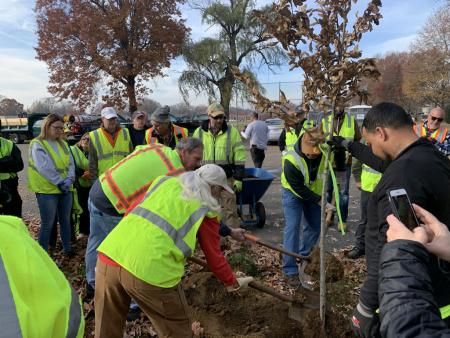Eighty-three percent of the U.S. population lives in urban areas. With summer heat waves and extreme weather worsening, cities are hit hard.
The buildings and concrete in cities absorb heat, spiking summer temperatures. In the winter, without enough green space, wind speeds increase, leading to heat loss. Both these phenomena contribute to high energy costs.
Greening East Springfield
The Greening the Gateway Cities Program (GGCP) is designed to reduce energy use by increasing tree cover in cities. Neighborhoods with little tree cover tend to be lower-income and face difficulty paying high energy bills, so GGCP is focused on these “Environmental Justice cities.”
The program e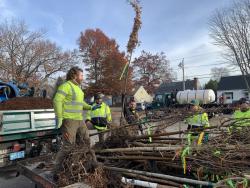 xpanded into East Springfield with the planting of fifty trees on November 16 and 17. This planting was made possible with critical-on-the-ground support and leadership from dozens of residents and representatives from the City of Springfield Forestry staff (including City Forester Alex Sherman), USDA Forest Service (Dr. David Bloniarz), and the University of Massachusetts (Dr. Rick Harper). Their goal is to plant an average of five trees per acre. With this amount of tree cover, the neighborhood will see a full return on their investment in 15 years in energy savings.
xpanded into East Springfield with the planting of fifty trees on November 16 and 17. This planting was made possible with critical-on-the-ground support and leadership from dozens of residents and representatives from the City of Springfield Forestry staff (including City Forester Alex Sherman), USDA Forest Service (Dr. David Bloniarz), and the University of Massachusetts (Dr. Rick Harper). Their goal is to plant an average of five trees per acre. With this amount of tree cover, the neighborhood will see a full return on their investment in 15 years in energy savings.
Harper is enthusiastic about the benefits of these urban trees: “Trees generate important environmental benefits and ecosystem services like shade, they sequester carbon.”
The people of East Springfield were delighted to see this group of volunteers planting trees in their neighborhood. “It means a lot. I think a lot of times East Springfield gets forgotten,” Marie Koski, a resident of East Springfield, said. 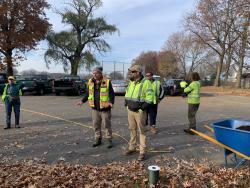
Energy Savings
In the summer, cities with too much concrete and too little tree cover experience the “Urban Heat Island Effect”—when buildings, roads, and urban infrastructure absorb and re-emit the sun’s heat far more than natural landscapes. This effect is worsened by the lack of tree shade.
In the winter, intense wind carries cold air across cities. When a neighborhood has high winds, poorly insulated homes lose a tremendous amount of heat. Mature tree trunks and branches interrupt and randomize these wind patterns, decreasing home heat loss through air infiltration.
Improving Air and Water Quality
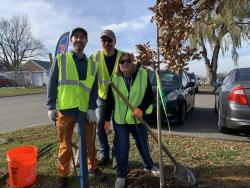 Urban forests also improve the air we breathe and consequently, can reduce the risk of respiratory disease. Trees, of course, produce oxygen and filter air pollutants, like nitrogen dioxide, sulfur dioxide, and ozone.
Urban forests also improve the air we breathe and consequently, can reduce the risk of respiratory disease. Trees, of course, produce oxygen and filter air pollutants, like nitrogen dioxide, sulfur dioxide, and ozone.
Their root systems also act as filters, removing pollutants from rainwater before it continues through the water cycle. These roots also prevent erosion and reduce flooding by absorbing water into the ground.
Strengthening Community and Health
Research has shown that the presence of trees can also increase one’s feeling of community and decrease stress. Green neighborhood spaces prove to be more social than those in “barren,” or concrete-covered neighborhoods. 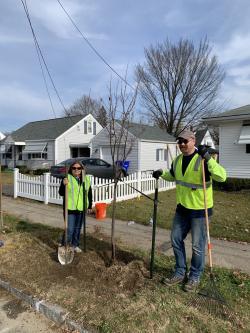
Populations with increased exposure to trees also experience lower levels of anxiety, depression, anger, confusion, and fatigue.
It’s clear that planting trees provides cities with a host of benefits. Springfield is not the only city in Massachusetts experiencing the advantages of this program, though!
The program is spread across the state and is active in Brockton, Chelsea, Chicopee, Fall River, Fitchburg, Haverhill, Holyoke, Lawrence, Leominster, Lowell, Lynn, New Bedford, Pittsfield, Quincy, Revere, Salem, Springfield, Westfield, Barnstable, Everett, Malden, Worcester, and Taunton.
GGCP is a partnership between the Executive Office of Energy and Environmental Affairs (EEA), the Department of Conservation and Recreation (DCR) Urban & Community Forestry Program, the Department of Energy Resources (DOER), the US Forest Service, and the Department of Housing and Community Development (DHCD), along with Gateway Cities and local grassroots organizations.
Visit www.mass.gov to learn more about the program and its benefits.
